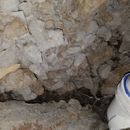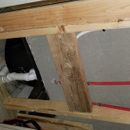Radon remediation – how do I seal this opening?
Bruce_Davis
| Posted in General Questions on
Question re Radon remediation. In the basement, I have a finished bathroom with full bathtub that backs to an unfinished area and the one square foot hole in the slab for the drain is open to the unfinished area. The other basement bathroom has a shower pan with the drain in the center, so I presume that slab hole is reasonably sealed by the pan.
How do I seal up this 12″ x 12″ x 4″ or 6″ hole. Great Stuff seems like an ideal solution, but the manufacturer says:
“GREAT STUFF is not to be used for filling closed cavities or voids such as behind walls and under tub surrounds; this improper use of the product could result in the accumulation of flammable vapors and/or uncured material.”
I thought about cutting up some foamboard and taping or foaming around the edges, but it’s a hard area to work with, don’t think I could get a good seal. Would have to break board up into multiple pieces to get in there.
I also have a few scraps left over of the 15 mil slab vapor barrier. Big enough to stick under slab with one piece but have the drain pipe in the way of getting a good seal. Hard to access for a good tape job. Maybe place material on top of hole and tape with Tyvek or Pella tape. Would that hold to concrete? But probably can’t reach the corner under bottom of tub.
Any ideas? Some kind of spray foam solution would be nice. I suppose filling with concrete could be a last resort. Thanks.
GBA Detail Library
A collection of one thousand construction details organized by climate and house part
Search and download construction details













Replies
Hi Bruce.
If you are hoping to keep it easy to access the plumbing, I guess you could try rigid foam and canned spray foam. I have used hydraulic cement to fill holes in slabs similar to this and it works well. Because it expands as it cures it will seal well around the plumbing and perimeter. You can fill up some of the void with gravel so that your patch isn't excessively deep.
For big odd-shaped holes like that in slabs, cut 3/16" or thicker Plexiglass or Lexan fit around the pipe with ~1/4-1/2" clearance, with a 2" overlap on the concrete all around, caulking the sheet plastic to the slab with polyurethane caulk. Cut a large U shape for the main piece, the a smaller overlapping U for sealing the rest caulking the plastic to the pipe & bottom plate framing (if necessary) with polyurethane caulk.
Dana, it's difficult to even slide a piece of paper under the part where the tub meets the slab. If I got the Plexiglas under there, wouldn't be able to caulk it.
Sounds like I need to make a bit of a mess with the cement. Brian, what would be the minimum thickness for the cement? I can put the vapor barrier in & a few inches of gravel. Would an inch or two of cement be sufficient so as to leave easy access to plumbing if need to remove this patch? Thanks.
I can't say that I measured precisely, but I think the similar patches I have made have been 1.5 to 2 inches thick and have held up fine. Good idea to patch the vapor barrier best you can.
>"Dana, it's difficult to even slide a piece of paper under the part where the tub meets the slab. If I got the Plexiglas under there, wouldn't be able to caulk it."
A very thin sheet of Lexan won't crack or tear, and may be your best bet for a truly gas-tight solution.
If there is really zero clearance, put some polyethylene sheeting over the gravel bed and pour a ~2-2.5" thick mini-slablet in the bottom of the sump can work. It won't take more than a bag of pre-mixed concrete (even 25 lbs. would be more than enough). Pre-wet the sides of the main slab, and be generous mixing in some concrete binding agent. As long as there is at least 1.5" of contact depth with the sides of the main slab it'll do just fine.
Filling a 12" x 12" hole to any depth would take quite a bit of hydraulic cement. That stuff sets up VERY quickly (think 5 minutes, not 5 hours), and contains no aggregate, making it easier to break than doing it with a pre-mixed concrete. If you can work quickly it's doable though. Hydraulic cement is more appropriately used in very small batches for filling cracks than making a one square foot 2" slab.
That's true. You have to work quickly, which is why I wouldn't recommend it that needed to look even remotely nice. When I have used it, to patch around the hole where a new supply pipe came into a basement from a well and to fill no longer used drians in a basement floor, have not been in areas where they would be seen. I've mixed it quickly, packed it into the area that needs to be filled and smoothed it with one or two quick passed with a trowel. This hole is a bit larger than any I have repair like this, but not by much. Regular cement is also an option.
It looks like you might be able to pour a thin slab just below the pipe to the tub drain if you dig out the pit a bit. The new mini slab would sit partially under the existing slab. This would make it easier to redo the drain to the tub if ever needed.
About a year ago, I did fill about halfway up the hole with hydraulic cement. I was trying to thin it a bit so it would self level as I can't get all the way in the space to properly pour. Didn't turn out so good; was way too thick. While I don't care that it looks ugly, I poured a bucket of water in the hopes it was sealed, but the water drained through quickly, probably in less than a minute.
I'm thinking of using true self-leveling concrete to add an inch or so, but only comes in 50 lb bags or caulking tubes. Can I thin the hydraulic cement for this purpose or do I need the get a 50 lb bag when I probably only need a few pounds? Thanks.